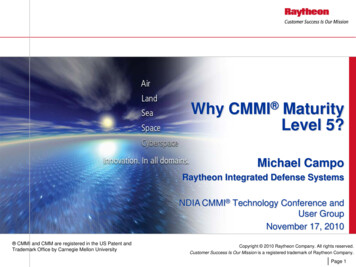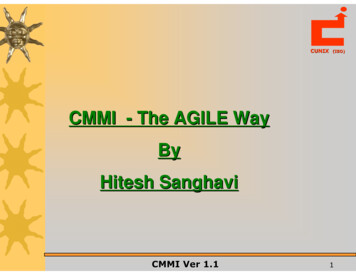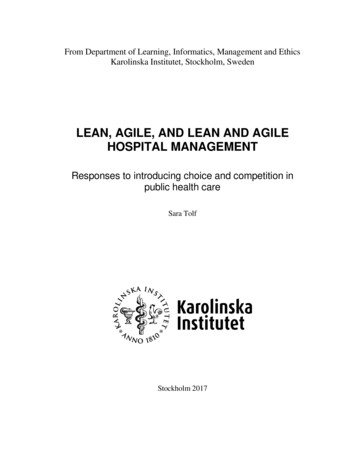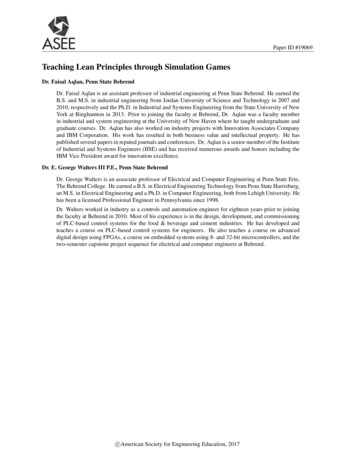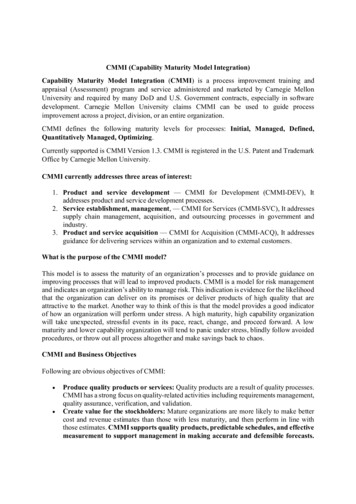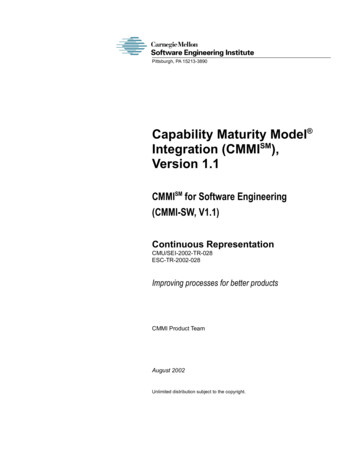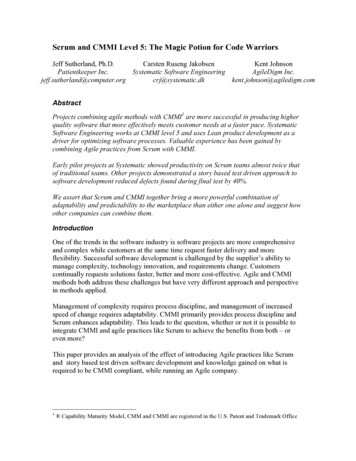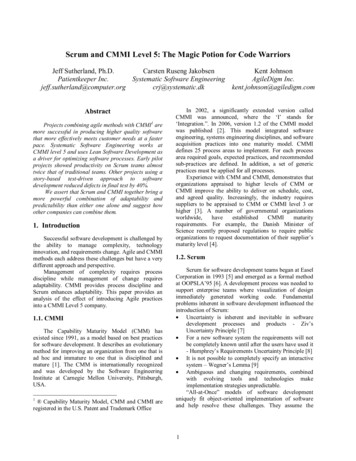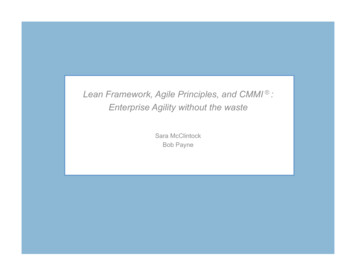
Transcription
Lean Framework, Agile Principles, and CMMI :Enterprise Agility without the wasteSara McClintockBob Payne
About The Application Development Center§ Centralized software development group focused onprocess and technical excellence§ Responsible for Nationwide’s most strategic applicationdevelopment§ A Lean and Agile software development organization§ Operational Excellence is in our DNAØ Culture of quality, predictable delivery, continuousimprovementØ Industry leader in software development2
Purpose, Process, and PeopleOur Path Forward3
Let’s Get Started on our Journey!§ Grassroots Beginnings§ Lean, Mean, CodingMachine§ Why CMMI?4
The Business View of ITOrigins of the Problem§ Complexity: IT projects are viewed by the business as extremely complexand hard to understand§ Misdirection: IT often fails to grasp the intentions of the business whenbuilding applications§ Project Failure: projects often run over-budget, late, and fail to deliver theexpected benefits§ Cost Focus: IT is often viewed as a cost center instead of a businessenabler§ Speed: the reaction time of IT to changing business environments isperceived as too slow5
The IT View of BusinessOrigins of the Problem§ Conflicting Priorities: the business is often unclear on what the priorities arefor the IT organization§ Lack of Inclusion: IT is often brought into projects late and are not offeredthe chance for collaboration§ Multitasking: too many projects are assigned to IT at once§ Gold-plating: excessive automation instead of doing the simplest thing thatworks adds to complexity§ Poor quality control: defect acceptance has become the norm and thebusiness does not want to invest in a quality product6
Grassroots BeginningAttacking the Problem with Agile§ Began in 2004§ Grassroots, practitioner led,extremely successful§ Lack of communication betweenAgile teamsAgile§ Localized Agile processes§ Each saw success, but had limitedimpact on the overall enterprise7
Enterprise AgileCoordination and Collaboration Begins§ Began in summer of 2008§ Harvested Agile best practices§ Nationwide’s leading Agile “activists”together for first time§ Focused on Scrum and XP practices§ Created Nationwide’s “21 Agile TeaLeaves”Agile§ Created a common understanding butstill lacked the ability to move the entireorganization in the same direction8
Nationwide’s 21 Agile Tea oryCardswithAcceptanceCriteria
The Application DevelopmentCenterNow that we have the pieces, whatdo we do with them?10
How Much Scale?§ Hundreds of millions of dollars spent on building software§ Thousands of IT associates§ Development platforms includedistributed, mainframe, mobile,and client-serverIT is the lifeblood of our industry –our products are data andinformation flows11
A Framework for AgileTo Summarize: no common purpose, no standards, inabilityto replicate agile successes across the enterprise How to tackle theseproblems?Operational Excellencerooted in a LeanApplication DevelopmentCenter12
Why Operational Excellence?Gaining a Competitive Advantage Through ProcessOperational Excellence – the ability to manage value creation processeswithout waste and better than the competition year after yearTheApplica consul ndprinciplesareusedtoimplementourvisionofopera onalexcellenceandextendagileprac roblems.13
Implementing OperationalExcellenceFirst, a review of Lean principles c onsExpertWorkersGoFast(jumptosolu gement(real- ‐ me)Portions from LEI presentation “Managing for Operational Excellence”, The Ohio State University, James P Womack14
Does Lean Apply to Creative Processes?Lean has had extreme success in the manufacturing and service sectorindustries, but could we apply the concepts to knowledge workers?Yes, but our experience tells us § More focus required on cultural buy-in§ Process focus to eliminate unnecessary variance, not to control creativity§ Concepts cannot be watered down – concepts should be customized toenvironment, but principles cannot be violated – a consistent reason fortransformation failure (don’t just do what is convenient)15
Our StrategyLearn from experience, partner with the bestFrom our experience with Agile software development, team transformationsneed three ingredients:§ § § Base education and philosophy to foster understandingSeeding of the teams with experienced practitionersOngoing coaching and reinforcementHowever, these three items would be insufficient for our broad-scale Leantransformation, we added § § Partnering with the Operational Excellence program at The Ohio StateUniversityA comprehensive program to transform management as well as staffSo, what did we actually do?16
Culture-Driven TransformationChange how you think bypracticing (kata) andreinforcing new behaviors(standard work)CultureThinking–WhatWeBelieveAc on–HowWeBehave17
The ADC Lean HouseA Framework for Our TransformationOpera1onalExcellenceLearningOrganiza onVisualManagementTheADCtransforma onfocusedoncrea ngasustainablesystem,notimplemen elopmentSystemOn Your Side dWorkKaizenWasteElimina onProblemSolvingCultureEmployeeEngagement18
Creating a Burning PlatformOrganizational Imperative to Act§ CMMI was leveraged as the measuring stick for our “WorldClass” Development Center.§ CMMI best practices included engineering, projectmanagement, and organizational practices.§ Our goal, to achieve CMMI L3 in 9 months.§ Final SCAMPI Assessment done by a 3rd party CMMI leadassessor.19
CMMI Reference ModelLevel 3 Process Areas (11) Requirements Development Technical Solution Product Integration Verification Validation Organizational Process Focus Organizational Process Definition Organizational Training Integrated Project Management Risk Management Decision Analysis and ResolutionLevel 2 Process Areas (7)1. Requirements Management2. Project Planning3. Project Monitoring and Control4. Measurement and Analysis5. Supplier Agreement Management6. Process and Product Quality Assurance7. Configuration Management
Visual ManagementReal-Time iatefeedbackandcorrec veac onintothesystem.Why make things visual?§ Encourages ‘go see’management§ Prevents informationhiding§ Common understanding§ Drives accountability§ Focuses the organizationon the importantmeasures21
Visual ManagementTypes of Visual ManagementDo the simplest thing that works –manual boards for a web developmentteam.Use technology judiciously and onlywhen it makes sense.22
Lean Development SystemThe Engine of a Lean IT evalue- theoverallsystem.The Development System:§ Creates an efficient process sequence with the lowestpossible waste§ Standardizes routine work items to allow our knowledgeworkers the freedom to concentrate on value-addedactivities§ Empowers team members to continuously improve upon thestandards and improve the entire ADC with their ideas23
Standardized WorkDevelopment System EnablementWhat is Standardized Work?“A standard is made up of only those elements which, when not followed, result in apredictable defect or waste” Dr. Ryuji FukadaGeneral work methods used to ensureconsistent processes and create abaseline for continuous improvementFunctional Application DevelopmentLifecycle including roles, workproducts, processes, patterns, tools,and metricsEntire Application DevelopmentCenter body of knowledge includingADLC, engagement, and seModelSCOPE
Standardized WorkBasis for Continuous ImprovementStabilizeStandardizeImproveWhy is standardization in the ADC important?Maintains a consistent level of qualityStabilizes the working conditionAllows for the judgment of normal from abnormal conditionsEnablingWaste EliminationIncreased ProductivityImproved MoraleFoundation for Improvement Activities
Waste EliminationIT Examples of the 8 WastesWasteExamplesDefectsIncomplete requirements, Softwaredefects, Change Failure, ProductionIncidentsTransportationMultiple steps for approvals forprocurement, security barriers toinformation flow, department handoffsOverproductionProducing reports nobody uses, fillingout paperwork that is not required,Extra requirements, Underutilizedapplications, tools (blackberries etc.)that are not usedWaitingWaiting for skills, funding,Infrastructure provisioning, downtimeOver-ProcessingMeetings, Manual Testing, Workingwithout tools, Features no one uses,i.e. gold platingMotionLack of standards, Lack ofdocumentation of how businessworks, searching for informationInventoryExcessive WIP, backlog, unbalancedflowUnderutilized talentNot involving staff in improvements,no continuous improvement programLean systems relentlesslypursue waste to root it out andrefocus activities and personnelon value-added activities.26
Lean Management SystemA Necessary Pillar for the Lean sesNeedLeanManagement!Without the LeanManagement System, thegains of implementing aLean Development Systemcannot be supported andmaintained.27
Lean Management SystemNothing Changes Until Leader Behavior ChangesLean culture grows from lean management§ § Embedding lean thinking into the organization cannot be doneunless we change the way our leaders thinkLean Managers are focused on value creating activities andbuilding a better system – instead of putting out fires, figure outhow to prevent the fires in the first placeBut how do you create lean ProcessDisciplinedManagement28
Leader Standardized WorkTraditional management placesemphasis on getting results atthe expense of process andsystem thinking.This creates short-term gains,but frequently causes naleanorganiza1on.29
Leader Standardized Work in theADCStandardized work is specific and focused on value addingactivities. Different levels in the organization have varyingamounts of standardized work versus discretionary work.DecreasingamountofstandardizedworkTeamLeaders Leadstandupmee ng Setupvisualmanagementsystemfortheday Periodicupdatesofvisualsystem A]endmanagementstandup Gembawalkwithmanager ReviewblockerboardDirectors Leadmanagementstandupmee ng Gembawalkwitheachteam Inspectvisualmanagementsystemperiodically Reviewdailyaccountabilityboard A]endexecu vestandupmee ng Reviewcon nuousimprovementboardExecu ves Leadexecu vestandupmee ng Gembawalkwitheachteam(weekly) Reviewdailyaccountabilityboard Reviewcon nuousimprovementboard30
Daily Accountability ProcessEnsuring Leaders are Focused on ValueTeamADLADE DailyStandupMee ng LocalTeamTopics DailyStandupwithTeamLeads Opera onalandImprovementTopicsThree interlocking tieredmeetings, less than 15minutes each. Focus is onprocess and results. DailyStandupwithADLs Opera onal,Improvement,TrendsThe presence of regular stand up meetings at all levels at theplace of work, along with the use of physical visuals is a keycharacteristic of lean organizations.31
Problem Solving CultureWhat is a problem solving culture?PlanAssumptionsProblemFacts and RootCause UnknownSolutionTraditional systems can encourage people tohide problems out of fear or simply notknowing what to do about them.ActDoCheckLean systems stop to address problems andfind root causes. Problem solving is adefined method rooted in the scientificapproach – not jumping to quick solutions.32
Problem Solving CultureCreate a competitive advantage by makingevery employee a problem-solving scientistA problem solving culture Empowers associates to tackleproblems Provides a defined channel and methodfor solving problems Educates associates about problemsolving techniques and tools to helpidentify and solve problems33
How Do We Create a Culture of Problem Solving?A3 as the Problem Solving MethodRemember Action drives Thinking1711§ A3issimplythepapersize–interna onal11x17§ Astandardformatforproblemsolving§ Tellsastorythatanyonecanunderstand–ononepage§ § Becomestheproblemsolvingcurrencyfortheorganiza on§ Isbestcreatedatthegemba34
A3 Example from “Managing toLearn”35
Kaizen, Continuous Improvement, and A3sRelentless Pursuit of Perfection/kai י zen/ - continuous incremental improvementKaizenisaphilosophyofcon spectsoftheorganiza reintheADC.Nationwide ADC Continuous Improvement§ Applies to both formal kaizen events and “kaizen eyes” –everyday continuous improvement to root out waste§ Is driven by practitioners§ Provides a governance mechanism for pushing changes into theADC Franchise Model§ Utilizes A3s to ensure PDCA thinking as well as other lean toolssuch as 5 Whys, Fishbone, etc.
Where are we today?§ § § § § Two years into our journeyScaled from 6 lines to 26 lines with plans for 6 more this yearFirst large-scale CMMI assessed lean and agile development center withzero known deficienciesRecognized in the industry as a leader in the lean software developmentspace – conduct regular gemba tours for companies across the US andaround the worldMost importantly § § § Focus on the processes have led to incredible quality gains, 23 of last26 releases in 2010 completely defect freeAssessment results (audits) of adherence to processes above 4.5 on a5 scaleContinuous improvement process fully operational
About NationwideNationwide is one of the largestinsurance and financial servicescompanies in the world with over 135B in statutory assets.We provide insurance, retirement,investments, and other productsto consumers in the US.Companies include Nationwide Insurance,Titan Insurance, Allied Insurance,Agribusiness, Nationwide Financial,Nationwide Retirement Solutions,Nationwide Bank, VPI, among others38
Thank You!
Lean Management System A Necessary Pillar for the Lean House 27 tforgetto! teach!our!managers!how!to!be!lean!leaders.!! Lean!Processes!Need!Lean!Management!! Without the Lean Management System, the ga
